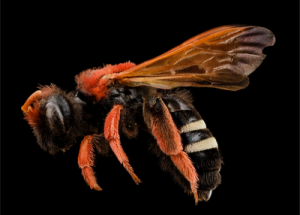Food securityWild bee decline threatens U.S. crop production
About 39 percent of U.S. croplands depend on pollinators — from apple orchards to pumpkin patches. Between 2008 and 2013, the number of bees in the contiguous United States declined in 23 percent, creating a mismatch between rising demand for pollination and a falling supply of wild bees. The first national study to map U.S. wild bees suggests they are disappearing in many of the country’s most important farmlands — including California’s Central Valley, the Midwest’s corn belt, and the Mississippi River valley. If losses of these crucial pollinators continue, the new nationwide assessment indicates that farmers will face increasing costs — and that the problem may even destabilize the nation’s crop production.

Wild bee decline threatens food supply // Source: udel.edu
The first national study to map U.S. wild bees suggests they are disappearing in many of the country’s most important farmlands — including California’s Central Valley, the Midwest’s corn belt, and the Mississippi River valley.
If losses of these crucial pollinators continue, the new nationwide assessment indicates that farmers will face increasing costs — and that the problem may even destabilize the nation’s crop production.
The findings were published 21 December in the Proceedings of the National Academy of Sciences.
Rising demand, falling supply
UVM reports that the research team, led by Insu Koh at the University of Vermont, estimates that wild bee abundance between 2008 and 2013 declined in 23 percent of the contiguous United States. The study also shows that 39 percent of U.S. croplands that depend on pollinators — from apple orchards to pumpkin patches — face a threatening mismatch between rising demand for pollination and a falling supply of wild bees.
In June of 2014, the White House issued a presidential memorandum warning that “over the past few decades, there has been a significant loss of pollinators, including honey bees, native bees, birds, bats, and butterflies.” The memo noted the multi-billion dollar contribution of pollinators to the U.S. economy — and called for a national assessment of wild pollinators and their habitats.
“Until this study, we didn’t have a national mapped picture about the status of wild bees and their impacts on pollination,” says Koh, a researcher at UVM’s Gund Institute for Ecological Economics — even though each year more than $3 billion of the U.S. agricultural economy depends on the pollination services of native pollinators like wild bees.
Trouble zones
The report that followed the White House memo called for seven million acres of land to be protected as pollinator habitat over the next five years. “It’s clear that pollinators are in trouble,” says Taylor Ricketts, the senior author on the new study and director of UVM’s Gund Institute. “But what’s been less clear is where they are in the most trouble — and where their decline will have the most consequence for farms and food.”
“Now we have a map of the hotspots,” adds Koh. “It’s the first spatial portrait of pollinator status and impacts in the U.S.,” — and a tool that the researchers hope will help protect wild bees and pinpoint habitat restoration efforts.
